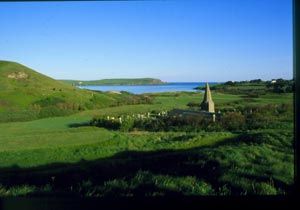England - The West Country
Former Golf Monthly editor Malcolm Campbell heads to the South-West of England to follow in the footsteps of Taylor, Braid and Vardon - the legendary Great Triumvirate

A century ago there was a dominant factor in the game of golf just as powerful then as Tiger is today. But it wasn t one man, it was three; a trio of players who dominated the game for more than two decades before the start of the First World War. They were two Englishmen from very different backgrounds and a gangling, softly-spoken Scot and they were all but invincible. Harry Vardon, John Henry Taylor and James Braid were The Great Triumvirate, superstars before the term was invented.
Their pre-eminence made them household names that were as big as Jack Nicklaus or Woods and crowds literally flocked for miles to see them play. Across the land no new course or clubhouse opening was complete without the presence of one or other or, often, all three. Between them they won 16 of 21 consecutive Open Championships and they moulded the future of the game.
Today the cold pages of history bear witness to their remarkable deeds but reveal little of the men themselves or recall the contribution each made to the sport.
Inevitably, with the passage of time, little remains as a living, collective reminder of these three great heroes of the past save, perhaps, for a famous painting, faded copies of which adorn many a clubhouse or locker room wall, while the original hangs rather dejectedly and obscurely, I always feel, on the staircase wall leading to the dining room in The R&A clubhouse.
It is true that we still enjoy the legacy of wonderful courses that James Braid s design magic left in trust to the nation and that Harry Vardon s life and his contribution to one of golf s defining moments has been recently and vividly brought back to life in Mark Frost s wonderful book now also a film The Greatest Game Ever Played. But of J H Taylor, there is little today recalled.
In some ways the current focus on one or other in isolation has the effect of fragmenting the Triumvirate, which fuelled my desire to find a way to reconnect with this remarkable and yet so diverse trio. I could think of no better way than to follow in their footsteps to a beautiful part of the country where the three great Open champions of the early 20th century left their mark and are well remembered.
The West Country, land of Camelot and Arthurian legend, of Tintagel, Dartmoor, Exmoor and Bodmin, of classic literature such as The Hound of the Baskervilles, Lorna Doone and Jamaica Inn, pirates and wreckers and the gastronomic empire of my favourite television chef, Rick Stein. These were the images that flooded to mind with the prospect of a journey to this Celtic outpost of mystery and magic to follow a Great Triumvirate Trail.
Get the Golf Monthly Newsletter
Subscribe to the Golf Monthly newsletter to stay up to date with all the latest tour news, equipment news, reviews, head-to-heads and buyer’s guides from our team of experienced experts.
In his own way each member of the Triumvirate made huge contributions to the game: Vardon is best remembered for his record of winning more Open Championships than anyone in history six in total as well as capturing the fledgling US Open in 1900; Braid as the first player to win five Opens, a feat he accomplished inside 10 years and which included three victories in a row, but now even more for his wonderful legacy of golf courses; Taylor as a five-time Open champion and founder of the PGA who also turned to golf course architecture in his later years with the two layouts at Royal Mid-Surrey his most famous creations.
At the first stop on this Great Triumvirate Tour, the Looe Golf Club, Harry Vardon is the hero. He laid out the course here in 1935 high on the moor where the views of Dartmoor and the Tamar estuary to the south, Looe Island and the Channel to the west and north and the glory of the Cornish countryside all around are quite stunning.
Here on the south coast of Cornwall we find a golf course largely open of aspect, marching its way over and across the moor and offering a challenge relatively short of length but so interesting of character.
Not much has changed since Vardon pondered his creation through the smoke haze of his favourite briar pipe and pronounced himself satisfied with the outcome. And why indeed would he not be? It would be a hard-hearted soul indeed who would fail to be moved by the splendour of the surroundings, or respond to the generous Cornish welcome of the unassuming clubhouse.
It cannot be classified as an overpowering challenge but when the wind whistles across the moor as it so often does, it is enough for most of us. And if golf courses reflect the character of those who design them, as they surely must, at Looe we soon get an early insight into the Vardon make-up.
Drive the ball straight and true, although not necessarily long, in the same way as the great man always did and the greens will present themselves to view with a welcoming prospect. Stray from the path of righteousness and you will feel the shrug of disapproval from the great man and pay a stiffish price for your failings.
That s the way of it under the Vardon flag; nothing grandiose, nothing big or muscular just a simple demand to do the simple thing but do it well or suffer the consequences.
By contrast when we move up the coast to St Enodoc to tackle the offering of the tall, splendidly-moustached and almost imperial figure of James Braid we enter a different world entirely.
Braid was a big man who thought big when it came to designing courses, and yet he was also renowned as a kindly and thoughtful man, a gentleman to whom decency and fairness were the very essence of his being. Wherever Braid built courses, and he built more than 250 in his long career, they were challenging but fair, always offering the poorer player hope. Boldly positioned greens and subtly-placed bunkers that often blurred perspective by their location just short of the green and fairway hazards which clearly proclaimed that to venture there was to indeed flirt with something hazardous, were the hallmarks of his work.
At St Enodoc he gave full rein to his philosophy of firm but fair and crafted one of the great natural links golf courses in the British Isles. In truth he had at his disposal a classic piece of linksland, simply stunning in a rough-hewn way, with rumpled ground and huge dunes over and around which he was able to set a challenge that ranks by common consent among the top 100 courses of the world.
Across the county line in Devon the third member of the Triumvirate, Taylor, is still king. Royal North Devon, better known the world over as Westward Ho!, is the oldest links in England and the course on which the great man learned to play as a youngster. This is golf laid bare, the way it was in the beginning, the purest form of our game and the one that many believe is still the model for all else.
Founded back in 1864 by the Reverend I H Gosset, this is a club of huge historical importance and its golf museum, honours boards and club trophies are worth the trip on their own.
Just as they did back in the young Taylor s day, sheep and horses still graze the course and the putting surfaces are protected from animal invasion by simple fences now constructed of a single strand of plastic tape, which barks defiantly against the onshore winds and gales that define this exposed stretch of Devon coastline.
Often referred to as The St Andrews of England , Westward Ho! remains largely unchanged since Taylor first set foot on it as a caddie boy. Golf Monthly s first editor, Harold Hilton, pronounced it England s finest competition course.
When J H finally retired to his native Northam in 1957 in his late 80s, he was invited to be president of the club. His portrait and several of the clubs he used to win his five Open Championships are proudly displayed there.
There is no finer place to end this memorable odyssey than in the ancient clubhouse, settled down in a comfortable old leather chair with a glass of mulled wine from the tap to hand, shrouded in a warm glow of reflection upon three men who really did change the game of golf forever.
CONTACTS BOOK
Where to play
Looe
T: 01503 240239
W: www.looegolfclub.co.uk
Stats: par 70, SSS 68, 5,940 yds
St Enodoc
T: 01208 863216
W: www.st-enodoc.co.uk
Stats: par 69, SSS 70, 6,547 yds
Royal North Devon
T: 01237 473817
W: www.royalnorthdevongolfclub.co.uk
Stats: par 72, SSS 72, 6,665 yds
Where to play
Metropole Hotel, Padstow
T: 0844 502 7587
W: www.richardsonhotels.co.uk/metropole_hotel.php
Trehellas House Hotel
T: 01208 72700
W: www.trehellashouse.co.uk
The Hoops Inn
T: 01237 451222
W: www.hoopsinn.co.uk
Off Course
The Eden Project
W: www.edenproject.com
Cornwall s living theatre of plants and people.
King Arthur s Great Hall
W: www.cornwall-online.co.uk/attractions/kingarthurshall
The story of King Arthur and the Knights of the Round Table.
Lappa Valley Steam Railway
W: www.lappavalley.co.uk
This narrow gauge steam railway runs on one of the oldest railway trackbeds in Cornwall.
-
 Angela Stanford’s Pursuit Of 100 Consecutive Majors Could End Painfully Short After Two Huge Blows
Angela Stanford’s Pursuit Of 100 Consecutive Majors Could End Painfully Short After Two Huge BlowsThe 46-year-old had been hoping to make a 99th successive Major appearance at the US Women's Open, but a double blow means her options are slimmer than ever
By Mike Hall Published
-
 ‘A Real Honour’ – Sky Sports Presenter Joins England Golf As Independent Director
‘A Real Honour’ – Sky Sports Presenter Joins England Golf As Independent DirectorSky Sports Golf presenter Sarah Stirk hopes to use her knowledge and experience to make the sport more open and accessible
By Andrew Wright Published